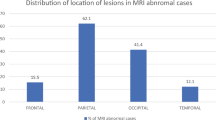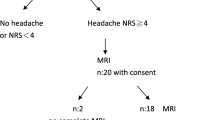Abstract
Need
Despite availability of intensive care units and improved antenatal care, some women still die from Eclampsia. Eclampsia is associated with increased risk of maternal death varying from 1.8 % in developed countries to 14 % in developing countries. Cerebral complications are the major cause of death in eclampsia patients. Eclampsia along with hypercoagulopathy of pregnancy is a high risk fact for patient in respect of development of cerebrovascular thrombosis/ischemic strokes. Eclampsia patients who are refractory to the routine treatment have been found to have various CNS pathological conditions amenable to the medical treatment.
Aims and Objectives
(1) To study the neuropathophysiology behind an eclamptic seizure to reduce the morbidity associated with it. (2) To study the role of neuroimaging in patients with atypical eclampsia.
Methodology
Prospective study design included 30 patients for the study. All patients were admitted in the eclampsia room with h/o convulsions. All patients were put on MgSO4 therapy and antihypertensives. The patients who are refractory to the treatment such as having recurrent convulsions despite therapy MgSO4 were selected for neuroimaging with CT scan. Neuroimaging is done using Phillips Tomoscan CT scanner where slices of 10-mm thickness were taken through the entire brain in the transaxial plane. Abdomen shielding is done with lead shield to prevent radiation hazard.
Result
S. No. | Findings | Number of patients | Percentage |
|---|---|---|---|
1 | Cerebral oedema | 20 | |
Mild to moderate | 17 | 56 | |
Severe | 03 | 10 | |
2 | Hypertensive encephalopathy | 05 | 16 |
3 | Posterior reversible encephalopathy syndrome | 11 | 36 |
4 | Cerebral infarction | 04 | 13 |
5 | Cortical venous sinus thrombosis | 02 | 16 |
6 | Tuberculomas | 02 | 06 |
7 | Meningitis | 01 | 03 |
8 | Hydrocephalus | 01 | 03 |
9 | Normal | 04 | 13 |
Conclusion
Eclampsia patients who were refractory to the treatment with MgSO4 and antihypertensives have been found to have very significant and morbid CNS pathological conditions. Neuroimaging in these patients have done a pivotal role in identifying the abnormality and rectifying it with medical means which had definitely improved patient's condition and have reduced morbidity.
Similar content being viewed by others
References
Villar MA, Sibai BM. Eclampsia. In: Arias F, editor. Obstetrics and gynaecology clinics of North America. Philadelphia: High Risk Pregnancy; 1988. p. 356–77.
Leitch CR, Cameron AD, Walker JJ. The changing pattern of eclampsia over a 60-year period. Br J Obstet Gynaecol. 1997;104:917–22 (Retrospective series; 1259 patients).
Mass JL, Lamy C. Stroke in pregnancy in the postpartum period. In: Ginsberg MD, Bogousslavsky J, editors. Cerebrovascular disease: pathophysiology, diagnosis and management. Malden: Blackwell Sciences; 1988. p. 1684–97.
Kanki T, Mihara F, Nakanoh. Diffusion weighted images and vasogenic oedema in pregnancy. Obstet Gynaecol. 1999;93:821–3.
Zeeman G, Flankestein JJ, Twickler DM. Cerebral Infarction in eclampsia. Am J Obstet Gynacol. 2002;100:140.
Manfredi M, Baltramello A. Eclamptic encephalopathy, neuroimaging and pathological consideration. Acta Neurol Scand. 1997;96:277–82.
Swartz RB, Feske SK, Polak JF, et al. Pre-ecalmpsia, eclampsia; clinical and neuroradiological correlates and insights in the pathogenesis of hypertensive encephalopathy. Radiology. 2000;217:317–76.
Zhu XW. Cerebral lesions in severe PIH: 61 cases study with computed tomographic scan. Zonghua Chan Ke Za Chi. 1993; 28(5)275–7, 313.
Iauska DJ. Peripartum stroke and intracranial vascular thrombosis in National Hospital Admissions. Obstet Gynacol. 1997;89:413–8.
Millez J, Dahoun A, Boudraa M, et al. Computed tomography brain in ecalmpsia. Am J Obstet Gynacol. 1990;75(6):975–80.
Naidu K, Modly J. SPECT, CT scan, and TCD findings in eclampsia. Br J Obstet Gynaecol. 1997;104(10):1162–72.
Author information
Authors and Affiliations
Corresponding author
Rights and permissions
About this article
Cite this article
Patil, M.M. Role of Neuroimaging in Patients with Atypical Eclampsia. J Obstet Gynecol India 62, 526–530 (2012). https://doi.org/10.1007/s13224-012-0181-5
Received:
Accepted:
Published:
Issue Date:
DOI: https://doi.org/10.1007/s13224-012-0181-5




